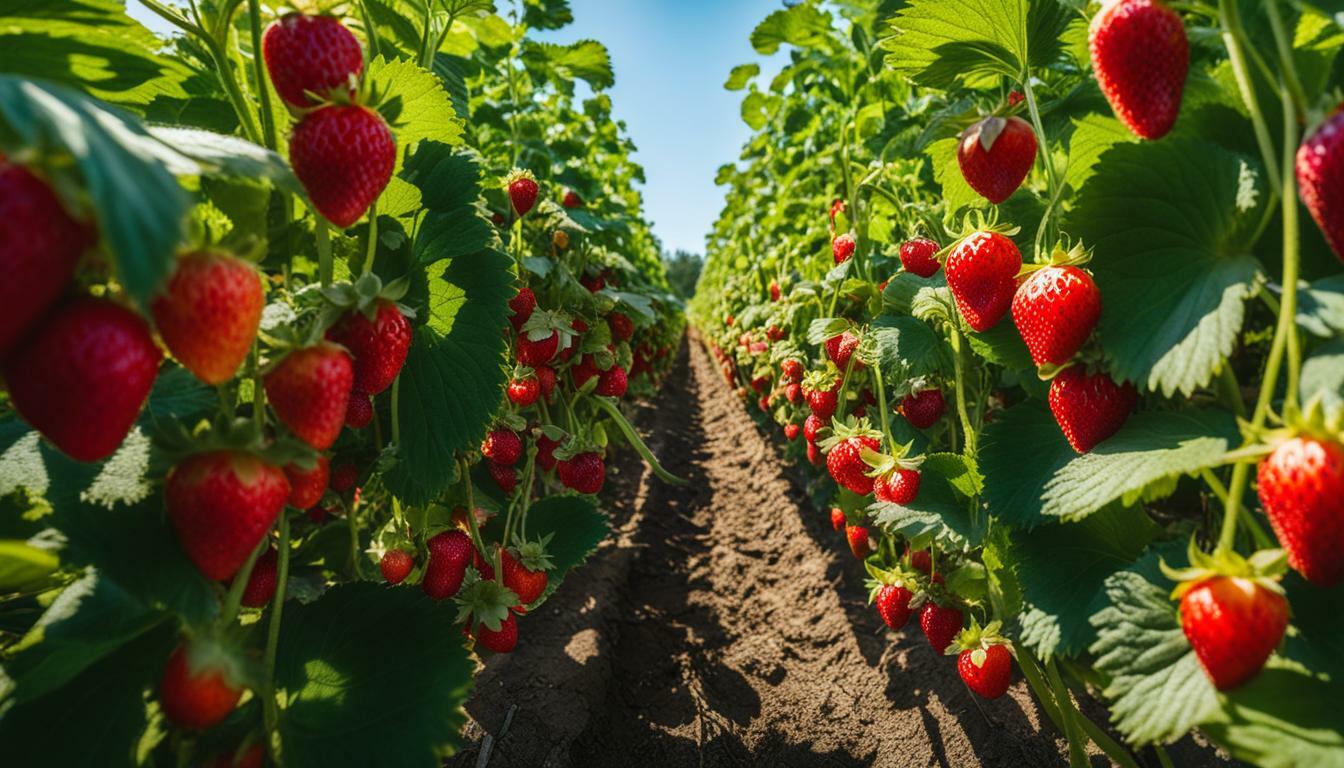If you have limited room and need to maximize your space, having a vertical strawberry garden may be the solution you are looking for. Growing strawberries vertically is a very efficient and easy solution to getting that strawberry fix. Not only does it save space, but it also offers numerous benefits such as increased yield, pest protection, and easier harvesting.
Key Takeaways:
- Vertical strawberry gardening is ideal for small spaces and allows you to grow strawberries in a space-saving manner.
- Strawberries can be grown vertically in various planters such as hanging planters, barrel or bucket planters, stackables, and pipe planters.
- Choosing the right strawberry variety is essential for vertical gardening, with ever-bearing and day-neutral varieties being popular choices.
- Growing strawberries indoors or outdoors in a vertical garden requires proper care, including selecting the right location, preparing the soil, and providing adequate watering and fertilization.
- Vertical strawberry gardening offers a rewarding experience, providing fresh, juicy strawberries while engaging your brain and promoting a healthy lifestyle.
Now that you understand the benefits and possibilities of vertical strawberry gardening, let’s explore in more detail how you can grow strawberries vertically and maximize your space.
Can You Grow Strawberries In A Vertical Garden?
Strawberries do very well in a vertical garden. Their shallow root systems don’t require planting in the ground with much soil. They need only enough soil to cover their roots. They’re almost designed to be grown vertically.
Aside from that, strawberries are generally very versatile and do well in many different environments, locations, and types of planters.
Benefits Of Growing Strawberries Vertically
Because you are utilizing space going up instead of space going out, you can grow more strawberries. Weeding is also less of a worry because it is harder for weeds to get in there.
Plus, growing your strawberries in a vertical garden will enable many of the berries to touch nothing but the open air, leading to fewer bacteria and fungi.
Benefits include:
- Protection against pests
- Protection against fungal diseases
- Easier to harvest
- Fits nearly anywhere
- Less chance of root rot
How To Grow Strawberries In A Vertical Garden
You can purchase a pre-made vertical planter or build one yourself. If the planter is big enough, you probably should alternate your strawberries with some herbs or salad greens because you can give yourself too many strawberries if you plant too many.
When buying or crafting a vertical planter, look for waterproof materials. This will protect the wall and floor from water damage. PVC pipe and old rain gutters are great places to start.
Plant your strawberries in early spring after the last frost. Place the strawberry plant towards the top of the soil in the planter, burying just the roots. Leave the crown out. You don’t want it to rot or dry out.
Make sure to plant your strawberries far enough away from each other to allow them room to grow. They are vine-like plants and will spread out with lots of runners.
Choose good quality soil to put them in to keep your strawberries growing for several years. Strawberries do best with ingredients like coconut coir, peat moss, perlite vermiculite, and some compost from your kitchen. The more acidic, the better.
Water your strawberries frequently, especially if it is hot out. Their shallow roots mean they go through the water quickly. But also be careful not to overwater because that will cause the roots to rot. Watering every 2-3 days is usually good.
Pick your berries once they’re red. But the longer you let them ripen, the sweeter they will be.
Here are some common types of vertical planters for your strawberries:
Hanging Planters
In hanging systems, you plant your strawberries in hanging pots or bags. Each strawberry plant gets its section, though if the pots are large enough, you might get away with two strawberry plants per pot.
The pots or bags do need drainage holes to keep instances of rotting down. So make sure that there is something underneath them to catch the water.
Barrel Or Bucket Planters
In this system, strawberries are planted in the sides of the barrel or bucket. First, you drill three-inch holes in the sides of the barrel, roughly 12-14 inches apart. Then you drill ¾ inch holes in the bottom of the bucket for drainage.
You fill the bucket with soil and put strawberries in each hole. If you want to get fancier or reduce the amount of soil in the bucket, you can put a thick PVC pipe in the center of the bucket. You can drill holes in the PVC pipe and then add water to the PVC pipe for a watering system.
You can also put strawberries at the top of the barrel or bucket, and they will take over entirely.
Stackables
Stackables come in many different shapes. You offset them by 45 degrees as you stack each one on top of another and then plant the strawberries in the available spaces.
You can also create a stackable by buying pots of different sizes and stacking them vertically. Then you put one plant in the top one, two in the next one down, three in the next one, and so on.
Either way, the bottom tier should be filled with gravel to function as your drainage.
Pipe Planters
These systems are usually made out of large PVC pipes or rain gutters. First, they can be mounted on the wall; then, strawberries are spaced out in these makeshift planters. Finally, you can mount them to the wall with the most sun if you put them outside.
Indoor Vertical Strawberry Garden
If you are planting your vertical strawberry garden indoors, ensure it is in a place where it will get as much sun as possible, preferably at least eight hours! If that’s not feasible, you can also get sunlamps for them to make up the difference.
The biggest challenge of an indoor strawberry garden after sunlight is water drainage. You don’t want to cause water damage to your floor or walls, so you need to set up some system that catches the water and allows it to evaporate, usually with rocks and gravel.
Outdoor Vertical Strawberry Garden
Vertical strawberry gardens work great in balconies and courtyards, and you can, of course, make them work in your backyard regardless of size. Strawberries naturally need a dormant season, so if you’re planting outside, know that they will do best in planting zones 3-8.
You don’t typically have to worry about water drainage outside, but you must be concerned about inclement weather. As hardy as strawberries are, they do not do well in the cold. They need a lot of sun to thrive, which is easier to attain outside. So don’t plant them in the shade.
The Best Type of Strawberry Variety to Grow in a Vertical Garden
There are two primary types of strawberry plants, ever-bearing and June-bearing.
Ever-bearing strawberries will continually produce berries throughout the season so that you can have multiple small harvests.
June-bearing strawberries will give one big harvest after about six weeks and then be done for the season.
Ever-bearing strawberries work best for home planters because the harvests are spread out. But you can pick whichever type best fits your needs. You can also mix and match.
Inspiration
I recommend the following video from “The Ripe Tomato Farms” for further inspiration, plus tips and tricks.

Final Words
Hopefully, you are more prepared to start your vertical strawberry garden! It is a great way to maximize your space and enjoy the delicious taste of homegrown strawberries. Happy gardening!
Benefits Of Growing Strawberries Vertically
Because you are utilizing space going up instead of space going out, you can grow more strawberries. Weeding is also less of a worry because it is harder for weeds to get in there.
One of the major advantages of growing strawberries in a vertical garden is the protection they provide against pests. When strawberries are grown vertically, it is more difficult for pests such as slugs and snails to reach the plants. This reduces the risk of damage and allows for healthier plants and a higher yield.
Growing strawberries vertically also offers protection against fungal diseases. By keeping the strawberries off the ground, there is less contact with moist soil, which can lead to the development of fungal infections. This results in healthier plants and a decreased risk of disease.
Another benefit of vertical strawberry gardening is easier harvesting. With the plants positioned at eye level or above, it eliminates the need to bend down or kneel on the ground to pick the strawberries. This makes the harvesting process more convenient and comfortable.
In addition to these benefits, growing strawberries vertically allows for greater flexibility in terms of location. Whether you have a small balcony, patio, or even just a windowsill, you can create your own strawberry garden. This makes vertical strawberry gardening accessible to individuals with limited outdoor space.
Furthermore, vertical gardening can help prevent root rot in strawberries. By providing proper drainage and allowing air circulation, the risk of root rot is minimized. This is particularly important for strawberries, as they have shallow root systems that are susceptible to waterlogging.
Overall, growing strawberries vertically offers numerous advantages, including increased yield, protection against pests and diseases, easier harvesting, flexibility in location, and prevention of root rot. It is a practical and efficient method for maximizing space and enjoying a bountiful harvest of delicious strawberries.
Table 1: Comparison of Benefits of Growing Strawberries Vertically
| Benefits | Description |
|---|---|
| Increased Yield | Utilizing vertical space allows for more strawberries to be grown. |
| Pest Protection | Growing strawberries vertically makes it harder for pests to reach the plants, reducing the risk of damage. |
| Protection against Fungal Diseases | By keeping the strawberries off the ground, there is less contact with moist soil, reducing the risk of fungal infections. |
| Easier Harvesting | With the plants positioned at eye level or above, there is no need to bend down or kneel on the ground to pick the strawberries. |
| Flexibility in Location | Vertical gardening allows for strawberries to be grown in small spaces such as balconies, patios, and windowsills. |
| Prevention of Root Rot | Providing proper drainage and air circulation helps prevent root rot in strawberries. |
“Because you are utilizing space going up instead of space going out, you can grow more strawberries. Weeding is also less of a worry because it is harder for weeds to get in there.” – Source
How To Grow Strawberries In A Vertical Garden
You can purchase a pre-made vertical planter or build one yourself. If the planter is big enough, you probably should alternate your strawberries with some herbs or salad greens because you can give yourself too many strawberries if you plant too many.
When buying or crafting a vertical planter, look for waterproof materials. This will protect the wall and floor from water damage. PVC pipe and old rain gutters are great places to start.
Plant your strawberries in early spring after the last frost. Place the strawberry plant towards the top of the soil in the planter, burying just the roots. Leave the crown out. You don’t want it to rot or dry out.
Make sure to plant your strawberries far enough away from each other to allow them room to grow. They are vine-like plants and will spread out with lots of runners.
| Vertical Planter Type | Advantages |
|---|---|
| Hanging Planters | • Suitable for small spaces and balconies • Easy to maintain and water |
| Barrel or Bucket Planters | • Can be customized and designed attractively • Good drainage and aeration for the plants |
| Stackables | • Space-saving and versatile • Easy to assemble and disassemble when needed |
| Pipe Planters | • Great for maximizing vertical space • Allows for efficient watering and nutrient distribution |
Indoor Vertical Strawberry Garden
If you are planting your vertical strawberry garden indoors, ensure it is in a place where it will get as much sun as possible, preferably at least eight hours! If that’s not feasible, you can also get sunlamps for them to make up the difference.
The biggest challenge of an indoor strawberry garden after sunlight is water drainage. You don’t want to cause water damage to your floor or walls, so you need to set up some system that catches the water and allows it to evaporate, usually with rocks and gravel.
Outdoor Vertical Strawberry Garden
Vertical strawberry gardens work great in balconies and courtyards, and you can, of course, make them work in your backyard regardless of size. Strawberries naturally need a dormant season, so if you’re planting outside, know that they will do best in planting zones 3-8.
You don’t typically have to worry about water drainage outside, but you must be concerned about inclement weather. As hardy as strawberries are, they do not do well in the cold. They need a lot of sun to thrive, which is easier to attain outside. So don’t plant them in the shade.
The Best Type of Strawberry Variety to Grow in a Vertical Garden
There are two primary types of strawberry plants, ever-bearing and June-bearing.
Ever-bearing strawberries will continually produce berries throughout the season so that you can have multiple small harvests.
June-bearing strawberries will give one big harvest after about six weeks and then be done for the season.
Ever-bearing strawberries work best for home planters because the harvests are spread out. But you can pick whichever type best fits your needs. You can also mix and match.
I recommend the following video from “The Ripe Tomato Farms” for further inspiration, plus tips and tricks.
Hopefully, you are more prepared to start your vertical strawberry garden! It is a great way to maximize your space and enjoy the delightful taste of homegrown strawberries.
Hanging Planters
In hanging systems, you plant your strawberries in hanging pots or bags. Each strawberry plant gets its section, though if the pots are large enough, you might get away with two strawberry plants per pot. The pots or bags do need drainage holes to keep instances of rotting down. So make sure that there is something underneath them to catch the water.
Advantages of Hanging Planters
- Maximize space: Hanging planters allow you to grow strawberries vertically, making efficient use of limited space. This is especially beneficial for those with small balconies or patios.
- Improved airflow: By suspending the plants, hanging planters provide better air circulation around the strawberry foliage, reducing the risk of fungal diseases.
- Easier maintenance: With hanging planters, you can easily access the plants for watering, pruning, and harvesting without having to bend down or kneel.
- Decorative appeal: Hanging planters add a visually appealing element to any space, enhancing the aesthetics of your vertical strawberry garden.
| Materials Needed | Pros | Cons |
|---|---|---|
| Hanging pots or bags | – Easy to install and remove – Portable – Allows for individual plant sections | – Limited soil capacity – Requires consistent watering – May require additional support for larger plants |
“Hanging planters are a fantastic option for growing strawberries vertically. They not only save space but also provide easy access for care and maintenance. Plus, they look great and can be a stylish addition to your outdoor or indoor space.”
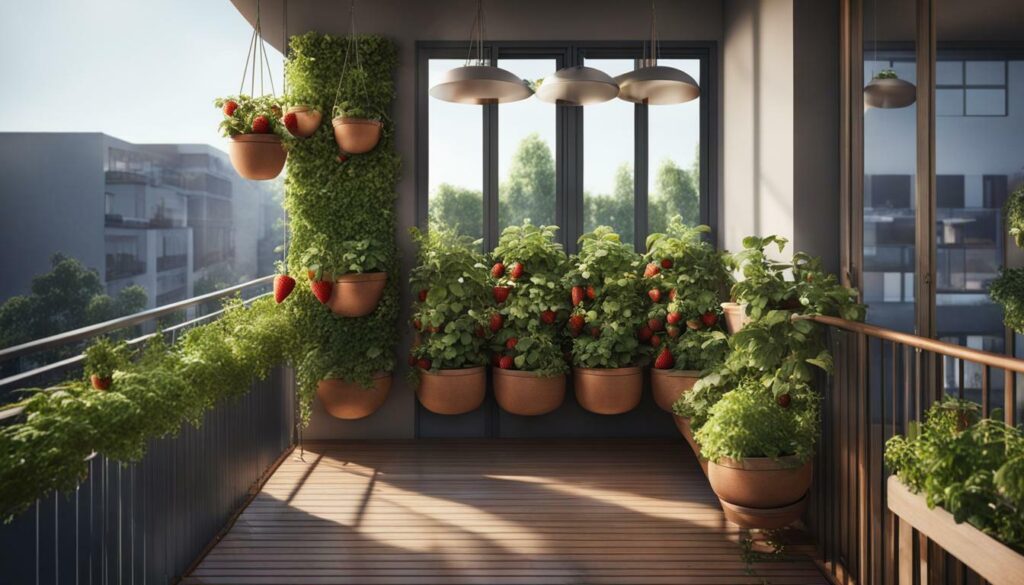
Whether you choose to hang your planters from a porch, balcony railing, or ceiling hooks, be sure to select a location that receives adequate sunlight for your strawberry plants. Remember to water them regularly, allowing the excess water to drain out to prevent root rot. With hanging planters, you can enjoy a bountiful harvest of fresh and delicious strawberries while adding a touch of greenery to your living space.
Barrel Or Bucket Planters
In this system, strawberries are planted in the sides of the barrel or bucket. First, you drill three-inch holes in the sides of the barrel, roughly 12-14 inches apart. Then you drill ¾ inch holes in the bottom of the bucket for drainage. The barrel or bucket acts as a container for the soil, providing a stable structure for the strawberry plants to grow.Once the holes are drilled, fill the barrel or bucket with high-quality soil mixed with compost. This will provide the necessary nutrients for the strawberry plants to thrive. Make sure to choose a soil mix that is well-draining to prevent waterlogged roots.After preparing the barrel or bucket, it’s time to plant the strawberries. Place each strawberry plant carefully into the pre-drilled holes, ensuring that the roots are covered with soil but the crown of the plant is exposed. The crown is the junction between the stem and the roots, and it should not be buried as it can lead to rotting or drying out.To maximize your strawberry yield, space the plants about 12-18 inches apart to allow room for growth. Strawberries are vine-like plants, and they tend to spread out with lots of runners. By giving each plant enough space, you’ll avoid overcrowding and encourage healthy growth.It’s important to water your strawberries regularly, especially during hot weather. Their shallow root system means they require frequent watering to prevent the soil from drying out. However, be careful not to overwater, as this can lead to root rot. Watering every 2-3 days is usually sufficient, but adjust based on the specific needs of your plants and the weather conditions.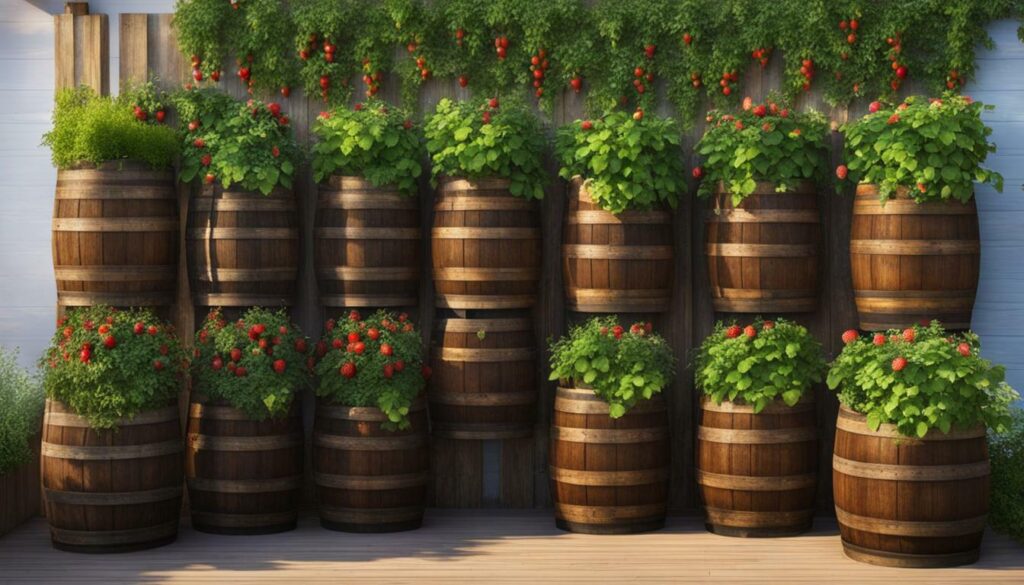 Barrel and bucket planters offer a convenient and space-saving solution for growing strawberries vertically. They allow you to utilize your vertical space effectively while providing a stable and secure environment for your plants. Additionally, they can be easily customized to fit your needs and preferences. For example, you can add a thick PVC pipe in the center of the bucket to reduce the amount of soil needed or create a watering system.By using barrel or bucket planters, you can enjoy a bountiful harvest of fresh, juicy strawberries right from your own garden. The vertical growth allows for better airflow and easier access to the berries, making the harvesting process more convenient. Whether you have a small balcony or a limited backyard space, barrel or bucket planters are a practical option for growing strawberries vertically.Here is a table summarizing the key points of growing strawberries in barrel or bucket planters:
Barrel and bucket planters offer a convenient and space-saving solution for growing strawberries vertically. They allow you to utilize your vertical space effectively while providing a stable and secure environment for your plants. Additionally, they can be easily customized to fit your needs and preferences. For example, you can add a thick PVC pipe in the center of the bucket to reduce the amount of soil needed or create a watering system.By using barrel or bucket planters, you can enjoy a bountiful harvest of fresh, juicy strawberries right from your own garden. The vertical growth allows for better airflow and easier access to the berries, making the harvesting process more convenient. Whether you have a small balcony or a limited backyard space, barrel or bucket planters are a practical option for growing strawberries vertically.Here is a table summarizing the key points of growing strawberries in barrel or bucket planters:| Advantages | Considerations |
|---|---|
| Efficient use of vertical space | Ensure proper drainage |
| Stable structure for plants | Choose a well-draining soil mix |
| Easier access to berries | Space plants adequately for growth |
| Customizable with PVC pipes or watering systems | Regular watering, but avoid overwatering |
Next up: Stackables
Stackables
Stackables come in many different shapes. You offset them by 45 degrees as you stack each one on top of another and then plant the strawberries in the available spaces. This vertical gardening solution is perfect for small spaces as it allows you to maximize your strawberry harvest without taking up a lot of room.
One popular option is to purchase stackable planters online, which are designed specifically for growing strawberries vertically. These planters are usually rectangular and can be easily stacked on top of each other. The 45-degree offset ensures that each planter gets enough sunlight, promoting healthy growth and fruit production.
If you prefer a DIY approach, you can also create your own stackable planters by using pots of different sizes. Start with a large pot at the bottom, fill it with gravel for drainage, and then stack progressively smaller pots on top, making sure to offset them by 45 degrees. Plant one strawberry plant in the top pot, two in the next one down, and so on. This arrangement allows the strawberries to cascade down the sides of the pots, creating a beautiful vertical garden.
| Advantages of Stackable Planters: |
|---|
| Maximize space utilization |
| Easy to set up and maintain |
| Allows for efficient watering and drainage |
| Can be customized to fit any space |
With stackable planters, you can easily create a stunning vertical strawberry garden that will not only save space but also add a touch of beauty to your outdoor or indoor environment. Whether you choose to purchase pre-made planters or create your own, stackable planters offer a convenient and versatile solution for growing strawberries in limited spaces.
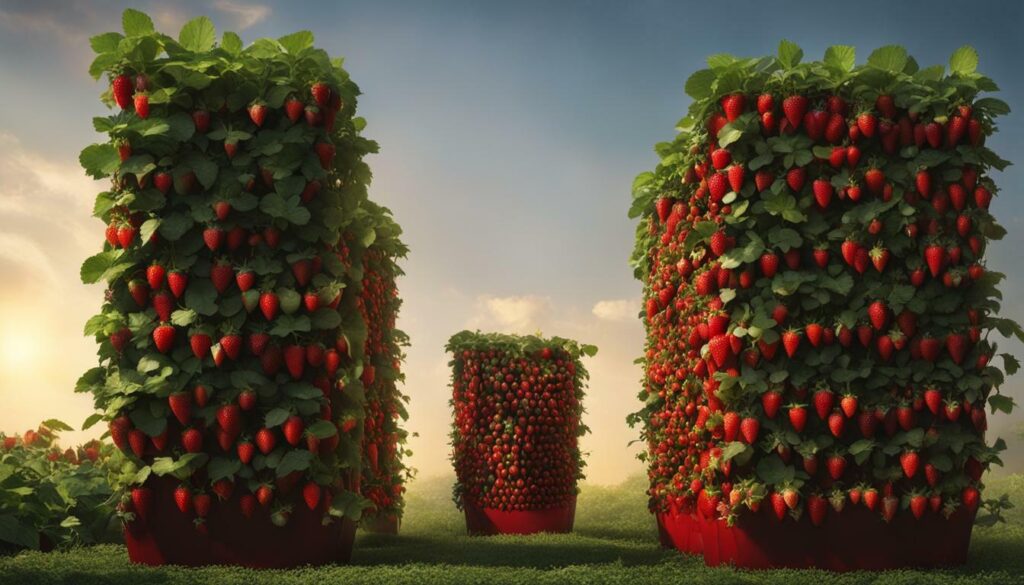
Stackables Offer Versatility and Style
In addition to their practicality, stackable planters also offer versatility and style. You can choose from a variety of designs and materials to complement your personal taste and the aesthetics of your space.
For a modern and sleek look, opt for stackable planters made of metal or plastic with clean lines and a minimalist design. These planters are lightweight and durable, making them easy to move and maintain.
If you prefer a more rustic or natural feel, consider stackable planters made of wood or terracotta. These materials add warmth and charm to your vertical garden and blend seamlessly with outdoor settings.
Regardless of the material or design you choose, stackable planters offer a convenient and attractive way to grow strawberries vertically, allowing you to enjoy fresh and juicy berries right at your fingertips.
Pipe Planters
These systems are usually made out of large PVC pipes or rain gutters. First, they can be mounted on the wall; then, strawberries are spaced out in these makeshift planters. PVC pipes or rain gutters provide a sturdy and durable structure for growing strawberries vertically.One advantage of using pipe planters is that they can be customized to fit any available space. You can choose the length and diameter of the pipes or gutters according to your needs. Additionally, they can be easily mounted on a wall or fence, saving valuable floor space.To create a pipe planter, drill holes at regular intervals along the length of the pipe or gutter. These holes will serve as the planting spots for the strawberry plants. The spacing between the holes should be determined by the growth habit of the strawberry variety you are planting.Once the holes are drilled, fill the pipe or gutter with a suitable planting medium, such as a mixture of compost, potting soil, and perlite. This will provide the necessary nutrients and drainage for the strawberry plants to thrive.After filling the pipe or gutter with the planting medium, carefully place the strawberry plants into the holes, ensuring that the roots are covered and the crowns are exposed. Gently press the soil around each plant to secure it in place.Water the strawberry plants regularly, keeping the soil consistently moist but not waterlogged. Monitor the plants for any signs of pests or diseases, and take appropriate measures to address any issues.Using pipe planters for growing strawberries vertically is an efficient and space-saving method that can yield abundant harvests. It allows you to make the most of limited space and enjoy the benefits of homegrown strawberries.Below is a complete table summarizing the key points of growing strawberries in pipe planters:| Advantages of Pipe Planters | How to Set Up Pipe Planters |
|---|---|
|
|
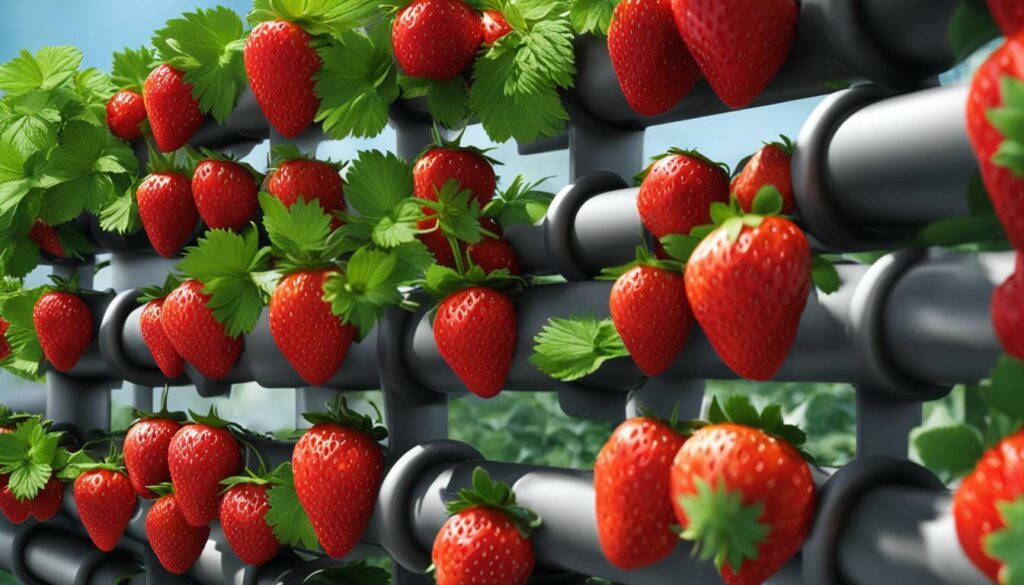
Indoor Vertical Strawberry Garden
If you are planting your vertical strawberry garden indoors, ensure it is in a place where it will get as much sun as possible, preferably at least eight hours! If that’s not feasible, you can also get sunlamps for them to make up the difference.
The biggest challenge of an indoor strawberry garden after sunlight is water drainage. You don’t want to cause water damage to your floor or walls, so you need to set up some system that catches the water and allows it to evaporate, usually with rocks and gravel.
However, planting the garden inside gives you easier access to your strawberries, and you don’t have to worry about frost.
When setting up your indoor vertical strawberry garden, consider using hanging baskets or wall-mounted planters. These allow you to grow strawberries vertically without taking up much space. Hanging baskets can be suspended from the ceiling or mounted on a wall, while wall-mounted planters can be attached to any available vertical surface.
With indoor gardening, you have more control over the growing environment, including temperature, humidity, and pest control. This allows you to create the ideal conditions for your strawberries to thrive. Regularly monitor the moisture level of the soil and adjust watering accordingly to prevent under or overwatering.
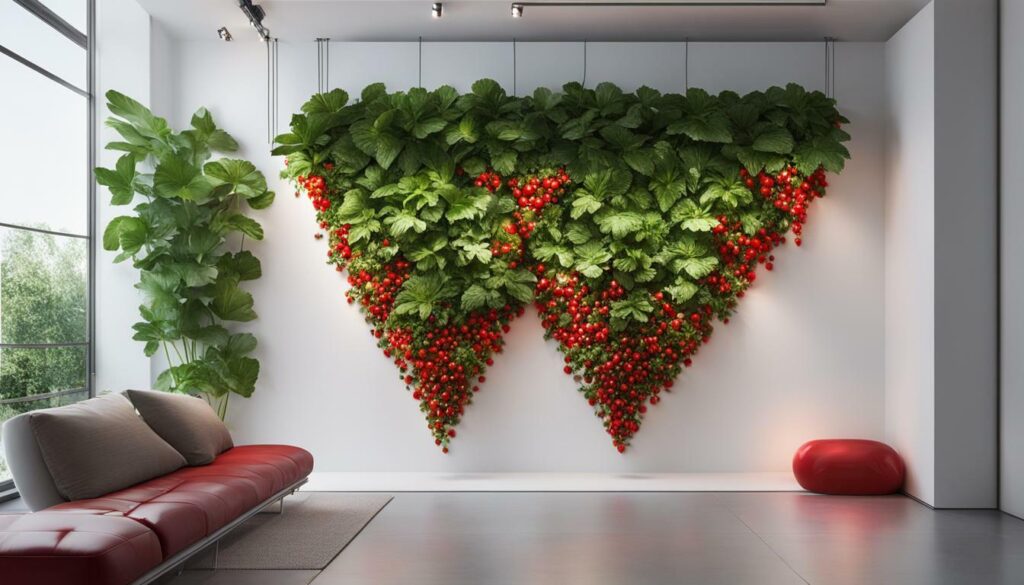
| Advantages of Indoor Vertical Strawberry Gardens | Tips for Indoor Vertical Strawberry Gardening |
|---|---|
|
|
Indoor vertical strawberry gardens offer a convenient and space-efficient way to grow strawberries. With the right setup and care, you can enjoy a bountiful harvest of fresh, juicy strawberries all year round.
Outdoor Vertical Strawberry Garden
Vertical strawberry gardens work great in balconies and courtyards, and you can, of course, make them work in your backyard regardless of size. This type of gardening allows you to maximize your space and grow a bountiful strawberry harvest even in limited areas. Whether you have a small balcony or a spacious courtyard, you can create a beautiful and productive outdoor vertical strawberry garden.
When choosing a location for your outdoor vertical strawberry garden, it’s important to consider sunlight exposure. Strawberries thrive in full sun, so select a spot that receives at least 6-8 hours of direct sunlight each day. This will ensure that your plants receive the necessary light to grow and produce abundant berries. Avoid areas with excessive shade or high winds, as these can negatively impact strawberry growth.
Preparing the soil is crucial for the success of your outdoor vertical strawberry garden. Strawberries prefer well-draining soil that is rich in organic matter. Remove any weeds or grass from the area where you plan to grow your strawberries. Loosen the soil with a garden fork or tiller, ensuring it is crumbly and free of large clumps. Incorporate organic matter such as compost or well-rotted manure to improve soil fertility and water retention. If your soil is heavy or clay-like, adding sand or perlite can help improve drainage.
When it comes to planting and spacing your strawberries in an outdoor vertical garden, proper spacing is essential for optimal growth and airflow. Space your strawberry plants about 12-18 inches apart, allowing them enough room to grow and spread. This will prevent overcrowding and promote healthy plant development. By providing adequate spacing, you allow each plant to receive sufficient light, nutrients, and airflow.
Here is a table summarizing the key steps for creating an outdoor vertical strawberry garden:
| Step | Description |
|---|---|
| Choose a sunny location | Select a spot that receives 6-8 hours of direct sunlight per day. |
| Prepare the soil | Remove weeds, loosen the soil, and incorporate organic matter for improved fertility and drainage. |
| Plant and space your strawberries | Space your strawberry plants 12-18 inches apart to allow for optimal growth and airflow. |
| Water and fertilize regularly | Provide consistent moisture and apply a balanced fertilizer according to package instructions. |
| Mulch to conserve moisture | Apply a layer of mulch around your strawberry plants to retain moisture and suppress weeds. |
| Harvest and enjoy your strawberries | Pick ripe strawberries as they appear and savor the delicious fruits of your labor. |
By following these steps and providing proper care, you can create a thriving outdoor vertical strawberry garden and enjoy a plentiful harvest of juicy, flavorful strawberries.
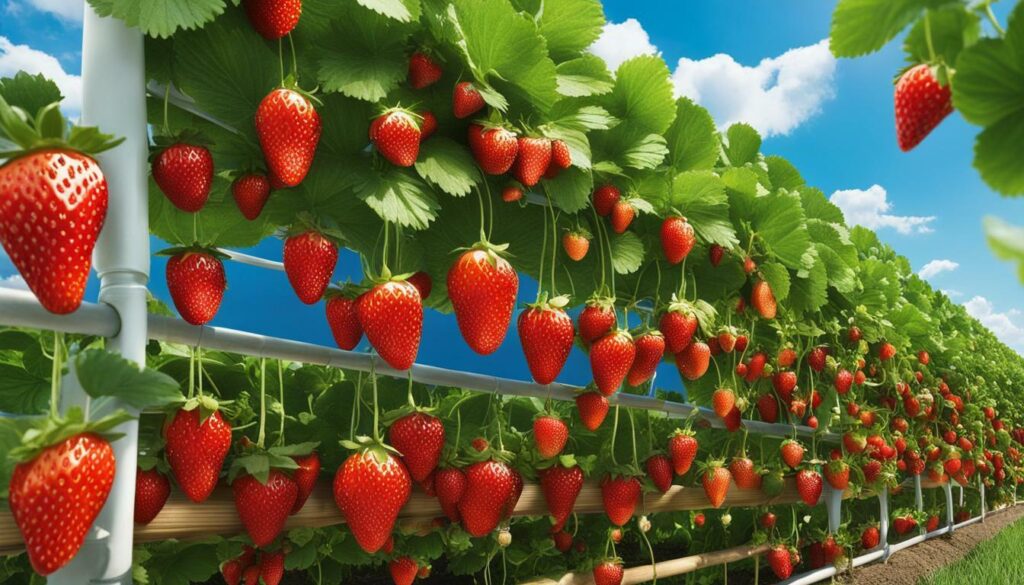
The Best Type of Strawberry Variety to Grow in a Vertical Garden
There are two primary types of strawberry plants, ever-bearing and June-bearing. Each type has its own unique characteristics and advantages when it comes to vertical gardening. Let’s take a closer look at each variety:
Ever-Bearing Strawberries
Ever-bearing strawberries are known for their continuous fruit production throughout the growing season. These plants produce a large crop in late spring or early summer, and then continue to produce smaller harvests until the first frost. This makes them a great choice for those who want a steady supply of strawberries throughout the year.
When growing ever-bearing strawberries in a vertical garden, it’s important to provide proper support for their runners. These plants tend to produce more runners than June-bearing varieties, so ensuring they have ample space to spread out vertically is essential. Staking or trellising systems can be used to support the runners and keep the plants organized in a vertical arrangement.
June-Bearing Strawberries
June-bearing strawberries are known for their large, juicy berries and concentrated harvest period. These plants produce a single, bountiful crop in late spring or early summer, typically lasting for about three weeks. This makes them an excellent choice for those who prefer a big harvest all at once, perfect for jam-making or enjoying fresh strawberries during the peak season.
When growing June-bearing strawberries in a vertical garden, it’s important to ensure that the plants have enough space to grow and spread out. These plants tend to produce fewer runners than ever-bearing varieties, so they may require less vertical support. However, providing a trellis or support system can still help to keep the plants organized and make harvesting easier.
| Strawberry Variety | Advantages |
|---|---|
| Ever-Bearing | Continuous fruit production throughout the season |
| June-Bearing | Large, concentrated harvest for jam-making or peak season enjoyment |
Regardless of the variety you choose, both ever-bearing and June-bearing strawberries can be successfully grown in vertical gardens. The key is to provide proper support, spacing, and care to ensure healthy growth and a bountiful harvest. With the right variety and vertical gardening techniques, you can enjoy delicious strawberries right from your own garden, no matter how limited your space may be.
Inspiration
I recommend the following video from “The Ripe Tomato Farms” for further inspiration, plus tips and tricks:
[embedded content]
Now that you’ve learned about the benefits of growing strawberries vertically and the different types of planters available, it’s time to get inspired and start your own vertical strawberry garden. Whether you have a small balcony, patio, or even just a windowsill, you can create a beautiful and productive strawberry paradise.
Watching strawberries grow and flourish in a vertical garden is not only rewarding but also a great way to engage your brain, stimulate problem-solving skills, and improve cognitive function. Growing strawberries in a small space allows you to enjoy the taste of fresh, juicy berries while also reaping the mental and physical health benefits of gardening.
Remember to choose the right strawberry variety that suits your space and desired harvest. Consider the location of your vertical garden, ensuring it receives enough sunlight for the strawberries to thrive. Prepare the soil with organic matter and proper drainage to create the optimal growing conditions for your plants.
Water and fertilize your strawberries regularly, providing them with the moisture and nutrients they need to produce abundant, flavorful berries. And don’t forget to harvest your strawberries when they are ripe and enjoy the fruits of your labor.
| Advantages of Growing Strawberries Vertically | Types of Vertical Planters |
|---|---|
|
|
By following these tips and using the right planter, you can create a thriving vertical strawberry garden that will provide you with an abundance of delicious berries. So why wait? Start your vertical strawberry garden today and enjoy the sweet rewards of homegrown strawberries!
Final Words
Hopefully, you are more prepared to start your vertical strawberry garden! It is a great way to maximize your space and indulge in homegrown freshness. Growing strawberries vertically offers numerous benefits, such as increased yield, pest protection, and easier harvesting. By choosing the right planter and following the proper planting and care instructions, you can enjoy a bountiful harvest of juicy and flavorful strawberries.
Whether you opt for hanging planters, barrel or bucket planters, stackables, or pipe planters, there are various options available to suit your space and preferences. Consider the location and climate when deciding whether to grow your strawberries indoors or outdoors, and choose the best strawberry variety for your vertical garden based on your desired harvest and available space.
Remember to water your strawberry plants regularly, ensuring they receive adequate moisture without overwatering. Adding organic matter to the soil and using balanced fertilizer will help promote healthy growth and superior fruit production. Enjoy the process of caring for your strawberry plants and watch as they thrive and bear delicious fruits.
So why wait? Start planning your vertical strawberry garden today and experience the joy of growing your own fresh strawberries right at home. Happy gardening!
Can I Use the Same Vertical Garden Structure for Both Strawberries and Herbs?
Yes, you can use the same vertical outdoor herb garden structure for both strawberries and herbs. This revolutionize the way we think about gardening, allowing for more efficiency and utilizing space in a creative way.
Can a 4 Tier Vertical Raised Garden Bed be Used for Growing Strawberries Vertically?
Yes, a 4 tier vertical raised garden bed can definitely be used for growing strawberries vertically. This setup can help maximize your garden space while allowing for proper drainage and easy access to the plants. Plus, it can also help protect your strawberries from pests and diseases.
FAQ
Q: Can you grow strawberries in a vertical garden?
A: Yes, strawberries can be grown successfully in a vertical garden. Their shallow root systems make them ideal for vertical planting, and they can thrive in various types of planters.
Q: What are the benefits of growing strawberries vertically?
A: Growing strawberries vertically allows you to maximize your space and grow more strawberries. It also provides protection against pests and fungal diseases, makes harvesting easier, and reduces the chance of root rot.
Q: How do you grow strawberries in a vertical garden?
A: You can purchase a pre-made vertical planter or build one yourself using materials like PVC pipe or rain gutters. Plant your strawberries in early spring, leaving enough space for them to grow. Choose good quality soil and water your strawberries frequently, but be careful not to overwater.
Q: What are some common types of vertical planters for strawberries?
A: Some common types of vertical planters for strawberries include hanging planters, barrel or bucket planters, stackables, and pipe planters. These planters offer different ways to grow strawberries vertically and can be adapted to suit your space and preferences.
Q: Can strawberries be grown in an indoor vertical garden?
A: Yes, strawberries can be grown in an indoor vertical garden. Ensure that the garden receives as much sunlight as possible, or consider using sunlamps. Proper water drainage is essential, so set up a system that catches and evaporates water to prevent damage to your floor or walls.
Q: What is the best type of strawberry variety to grow in a vertical garden?
A: There are two primary types of strawberry plants: ever-bearing and June-bearing. Ever-bearing strawberries produce multiple small harvests throughout the season, while June-bearing strawberries provide one big harvest. The choice depends on your preference and the desired harvest.
Q: How do I start planting strawberries?
A: Strawberry plants can be planted from seedlings or pre-cultivated plants bought from a gardening store or nursery. Plant them in early spring after the last frost. Ensure that the crown of the plant is not buried to prevent rot or drying out. Use good quality soil with added compost and water your strawberries regularly.
Q: How often should I water my strawberries?
A: Water your strawberries frequently, especially in hot weather. Their shallow roots require regular watering, but be careful not to overwater as it can lead to root rot. Watering every 2-3 days is generally sufficient.

